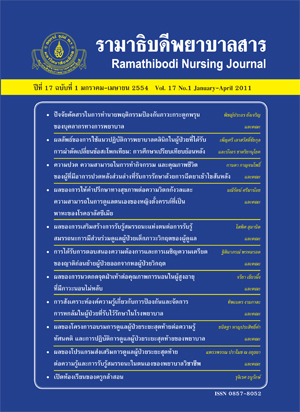ผลลัพธ์ของการใช้แนวปฏิบัติการพยาบาลคลินิกในผู้ป่วยที่ได้รับการผ่าตัด เปลี่ยนข้อสะโพกเทียม: การศึกษาเปรียบเทียบย้อนหลัง
Main Article Content
Abstract
บทคัดย่อ
การศึกษาครั้งนี้เป็นการศึกษาย้อนหลัง เพื่อเปรียบเทียบผลลัพธ์ของการพยาบาลผู้ป่วยที่ได้รับการผ่าตัดเปลี่ยนข้อสะโพกเทียม ในด้านความปวดหลังผ่าตัด จำนวนวันที่ลุกเดินได้ครั้งแรกหลังผ่าตัด ระยะเวลานอนโรงพยาบาล ภาวะแทรกซ้อนหลังผ่าตัด และการกลับเข้ารับการรักษาในโรงพยาบาลภายใน 3 เดือนหลังผ่าตัดโดยไม่ได้วางแผน ระหว่างกลุ่มที่ได้รับการพยาบาลตามปกติกับกลุ่มที่ได้รับการพยาบาลโดยใช้แนวปฏิบัติการพยาบาลทางคลินิก กลุ่มตัวอย่างเป็นผู้ป่วยที่ได้รับการผ่าตัดเปลี่ยนข้อสะโพกเทียมที่หอผู้ป่วยออร์โธปิดิกส์ โรงพยาบาลรามาธิบดีจำนวน 80 ราย โดยแบ่งเป็นกลุ่มที่ได้รับการพยาบาลตามปกติ (กลุ่ม 1) ในช่วงเดือนกรกฏาคม2548 ถึง ธันวาคม 2548 จำนวน 40 ราย และกลุ่มผู้ป่วยที่ได้รับการพยาบาลโดยใช้แนวปฏิบัติการพยาบาลคลินิก (กลุ่ม 2) ในช่วงเดือนมกราคม 2549 ถึง พฤษภาคม 2549 จำนวน 40 รายลักษณะทั่วไปของกลุ่มตัวอย่างทั้ง 2 กลุ่มไม่แตกต่างกัน ส่วนใหญ่เป็น ผู้สูงอายุเพศหญิง เป็นโรคกระดูกสะโพกหัก มีอายุเฉลี่ย 65.55 ปี และ 66.33 ปี ในกลุ่ม 1 และกลุ่ม 2 ตามลำดับ ผลการศึกษาพบว่ากลุ่ม 2 มีคะแนนความปวดหลังผ่าตัดน้อยกว่า จำนวนวันที่ลุกเดินได้ครั้งแรกหลังผ่าตัดเร็วกว่า ระยะเวลานอนโรงพยาบาลน้อยกว่าและภาวะแทรกซ้อนภายหลังผ่าตัดน้อยกว่ากลุ่ม 1แต่พบว่าสองกลุ่มไม่แตกต่างกันอย่างมีนัยสำคัญทางสถิติ ภาวะแทรกซ้อนที่พบมากที่สุดหลังผ่าตัดคือ การติดเชื้อระบบทางเดินปัสสาวะ รองลงมาคือ ภาวะสับสนเฉียบพลัน เลือดออกในระบบทางเดินอาหาร และปอดแฟบ อาการไม่พึงประสงค์หลังผ่าตัดที่พบมากที่สุด คือ อาการท้องผูกผลจากการศึกษานี้เป็นพื้นฐานสำคัญที่นำไปสู่การพัฒนาแนวปฏิบัติการพยาบาลเพื่อให้เกิดผลลัพธ์ทางการพยาบาลที่มีประสิทธิภาพมากยิ่งขึ้น
คำสำคัญ : แนวปฏิบัติการพยาบาลคลินิก, ผู้ป่วยที่ได้รับการผ่าตัดเปลี่ยนข้อสะโพกเทียม, การพยาบาลผลลัพธ์การพยาบาล, ผู้สูงอายุ
Abstract
This retrospective comparative study aimed to compare the outcomes ofnursing care for hip arthroplasty patients on postoperative pain, the number of days forthe first postoperative ambulation, length of stay (LOS), postoperative complicationsand unplanned readmission within 3 months after operation. The sample consisted of80 patients with hip arthroplasty who were admitted to orthopaedic wards, RamathibodiHospital, Thailand. The sample was divided into two groups, which consisted of 40participants in each group. The control group (Group 1) consisted of participants whoreceived usual nursing care and were admitted from July 2005 to December 2005.The intervention group (Group 2) consisted of participants who received nursingcare using evidence-based clinical nursing practice guideline for hip arthroplastypatients and were admitted from January 2006 to May 2006. The characteristics ofparticipants among Group 1 and Group 2 were not significantly different. The majoritywas elderly female and was diagnosed as hip fracture. The mean ages were 65.55and 66.33 years in Group 1 and Group 2, respectively. The results showed thatGroup 2 had less postoperative pain score, number of days for the first postoperativeambulation, LOS, and postoperative complications than did Group 1, but they were notsignificantly different. Most postoperative complications were urinary tract infection,acute confusional state, upper gastrointestinal bleeding, and lung atelectasis. The mostcommon postoperative side effect in this study was constipation. Results of this studyare useful for improving clinical nursing practice guidelines to enhance more effectivenursing outcomes in this area.
Keywords : Clinical nursing practice guideline, Hip arthroplasty, Nursing care, Nursingoutcomes, Older patients
Article Details
บทความ ข้อมูล เนื้อหา รูปภาพ ฯลฯ ที่ได้รับการตีพิมพ์ในรามาธิบดีพยาบาลสาร ถือเป็นลิขสิทธิ์ของวารสาร หากบุคคลหรือหน่วยงานใดต้องการนำทั้งหมดหรือส่วนหนึ่งส่วนใดไปเผยแพร่หรือเพื่อกระทำการใด ใด จะต้องได้รับอนุญาตเป็นลายลักษณ์อักษรจากรามาธิบดีพยาบาลสารก่อนเท่านั้น


